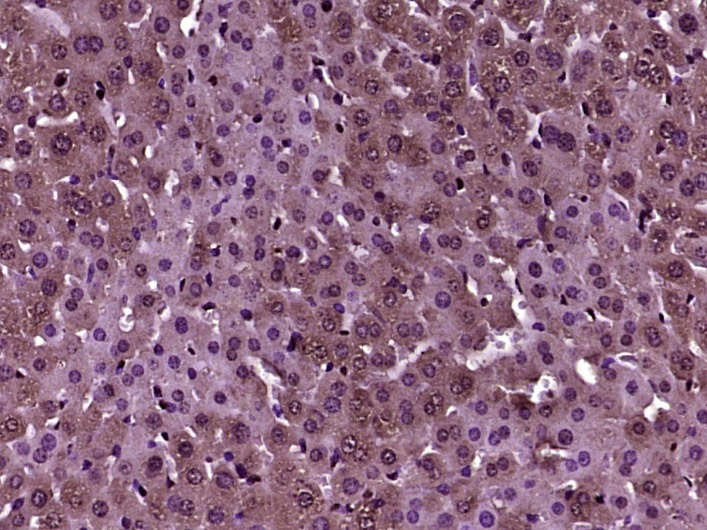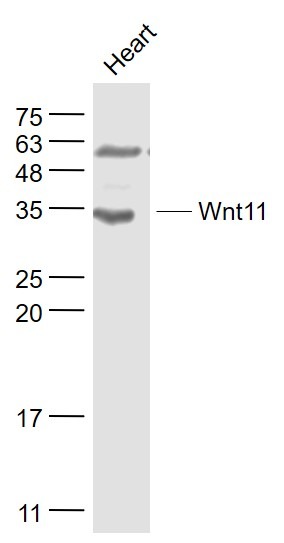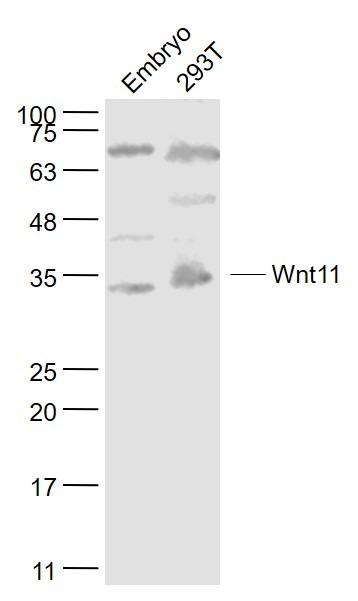Shopping Cart
Remove All Your shopping cart is currently empty
Your shopping cart is currently empty
Anti-Wnt11 Polyclonal Antibody is a Rabbit antibody targeting Wnt11. Anti-Wnt11 Polyclonal Antibody can be used in IF,IHC-Fr,IHC-P,WB.
| Pack Size | Price | USA Warehouse | Global Warehouse | Quantity |
|---|---|---|---|---|
| 50 μL | $220 | 7-10 days | 7-10 days | |
| 100 μL | $374 | 7-10 days | 7-10 days | |
| 200 μL | $528 | 7-10 days | 7-10 days |
| Description | Anti-Wnt11 Polyclonal Antibody is a Rabbit antibody targeting Wnt11. Anti-Wnt11 Polyclonal Antibody can be used in IF,IHC-Fr,IHC-P,WB. |
| Synonyms | wnt11b, wnt-11, Wingless-type MMTV integration site family, member 11B, Wingless-type MMTV integration site family, member 11, Wingless-type MMTV integration site family, member 1, Wingless-related MMTV integration site 11, Protein Wnt-11, HWNT11 |
| Ig Type | IgG |
| Reactivity | Human,Mouse (predicted:Rat,Dog,Pig,Cow,Horse,Rabbit) |
| Verified Activity | 1. Paraformaldehyde-fixed, paraffin embedded (mouse liver tissue); Antigen retrieval by boiling in sodium citrate buffer (pH6.0) for 15 min; Block endogenous peroxidase by 3% hydrogen peroxide for 20 min; Blocking buffer (normal goat serum) at 37°C for 30 min; Antibody incubation with (Wnt11) Polyclonal Antibody, Unconjugated (TMAB-01982) at 1:400 overnight at 4°C, followed by operating according to SP Kit (Rabbit) instructionsand DAB staining. 2. Sample: Heart (Mouse) Lysate at 40 μg Primary: Anti-Wnt11 (TMAB-01982) at 1/1000 dilution Secondary: IRDye800CW Goat Anti-Rabbit IgG at 1/20000 dilution Predicted band size: 36 kDa Observed band size: 34 kDa 3. Sample: Embryo (Mouse) Lysate at 40 μg 293t (Human) Cell Lysate at 30 μg Primary: Anti-Wnt11 (TMAB-01982) at 1/1000 dilution Secondary: IRDye800CW Goat Anti-Rabbit IgG at 1/20000 dilution Predicted band size: 36 kDa Observed band size: 35 kDa    |
| Application | |
| Recommended Dose | WB: 1:500-2000; IHC-P: 1:100-500; IHC-Fr: 1:100-500; IF: 1:100-500 |
| Antibody Type | Polyclonal |
| Host Species | Rabbit |
| Subcellular Localization | Secreted; extracellular space; extracellular matrix. |
| Tissue Specificity | Expressed in fetal lung, kidney, adult heart, liver, skeletal muscle, and pancreas. |
| Construction | Polyclonal Antibody |
| Purification | Protein A purified |
| Appearance | Liquid |
| Formulation | 0.01M TBS (pH7.4) with 1% BSA, 0.02% Proclin300 and 50% Glycerol. |
| Concentration | 1 mg/mL |
| Research Background | The Wnt genes belong to a family of protooncogenes with at least 13 known members that are expressed in species ranging from Drosophila to man. The name Wnt denotes the relationship of this family to the Drosophila segment polarity gene ”wingless” and to its vertebrate ortholog, Int-1, a mouse proto-oncogene. Transcription of Wnt family genes appears to be developmentally regulated in a precise temporal and spatial manner. The Wnt genes encode cysteine-rich putative glycoproteins which have features typical of secreted growth factors. Wnt-11 is expressed in the tips of ureteric buds and in the perichondrium, a stem cell-like layer that surrounds the future bones and directs their growth and regeneration. Wnt-11 activity is required for cells to undergo correct convergent extension movements during gastrulation. Human Wnt-11 is also expressed in the lung mesenchyme, the urorectal septum, the urogenital folds, the labioscrotal swellings, and the cortex of the adrenal gland. Unlike other Wnt family members, Wnt-11 is not expressed in the neuroepithelium of the central nervous system. Wnt-11, along with Wnt-8c, is ex-pressed in the posterior region of the chick embryo in the caudal paraxial mesoderm that underlies the prospective caudal neural plate. The gene which encodes Wnt-11 maps to human chromosome 11q13.5. |
| Immunogen | KLH conjugated synthetic peptide: human Wnt11 |
| Antigen Species | Human |
| Gene Name | WNT11 |
| Gene ID | |
| Protein Name | Protein Wnt-11 |
| Uniprot ID | |
| Biology Area | Secreted |
| Function | Wnt11 is a non-canonical Wnt which is expressed in androgen-independent prostate cancer cell lines and prostate tumours. It is involved in development, including cardiac and gut development. |
| Molecular Weight | Theoretical: 36 kDa. |
| Stability & Storage | Store at -20°C or -80°C for 12 months. Avoid repeated freeze-thaw cycles. |
| Transport | Shipping with blue ice. |
| Size | Quantity | Unit Price | Amount | Operation |
|---|

Copyright © 2015-2026 TargetMol Chemicals Inc. All Rights Reserved.